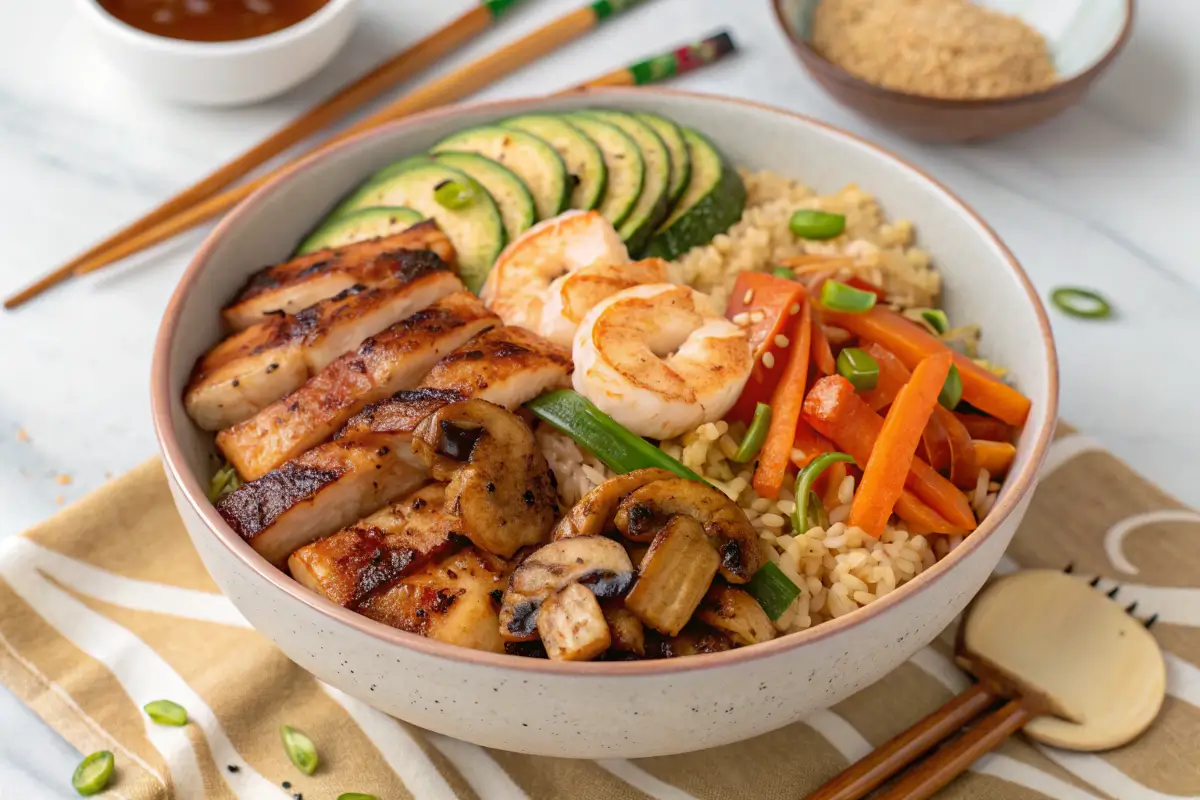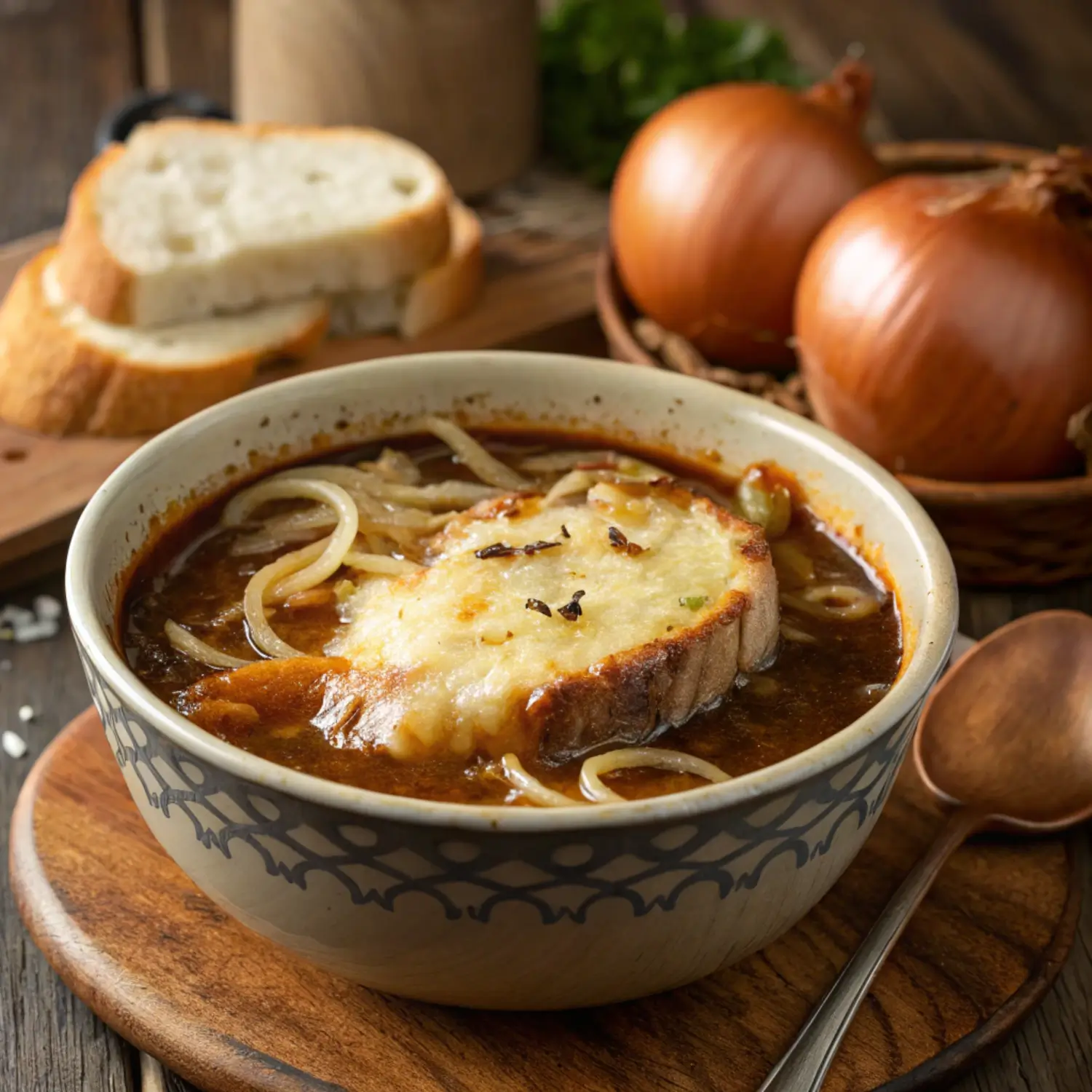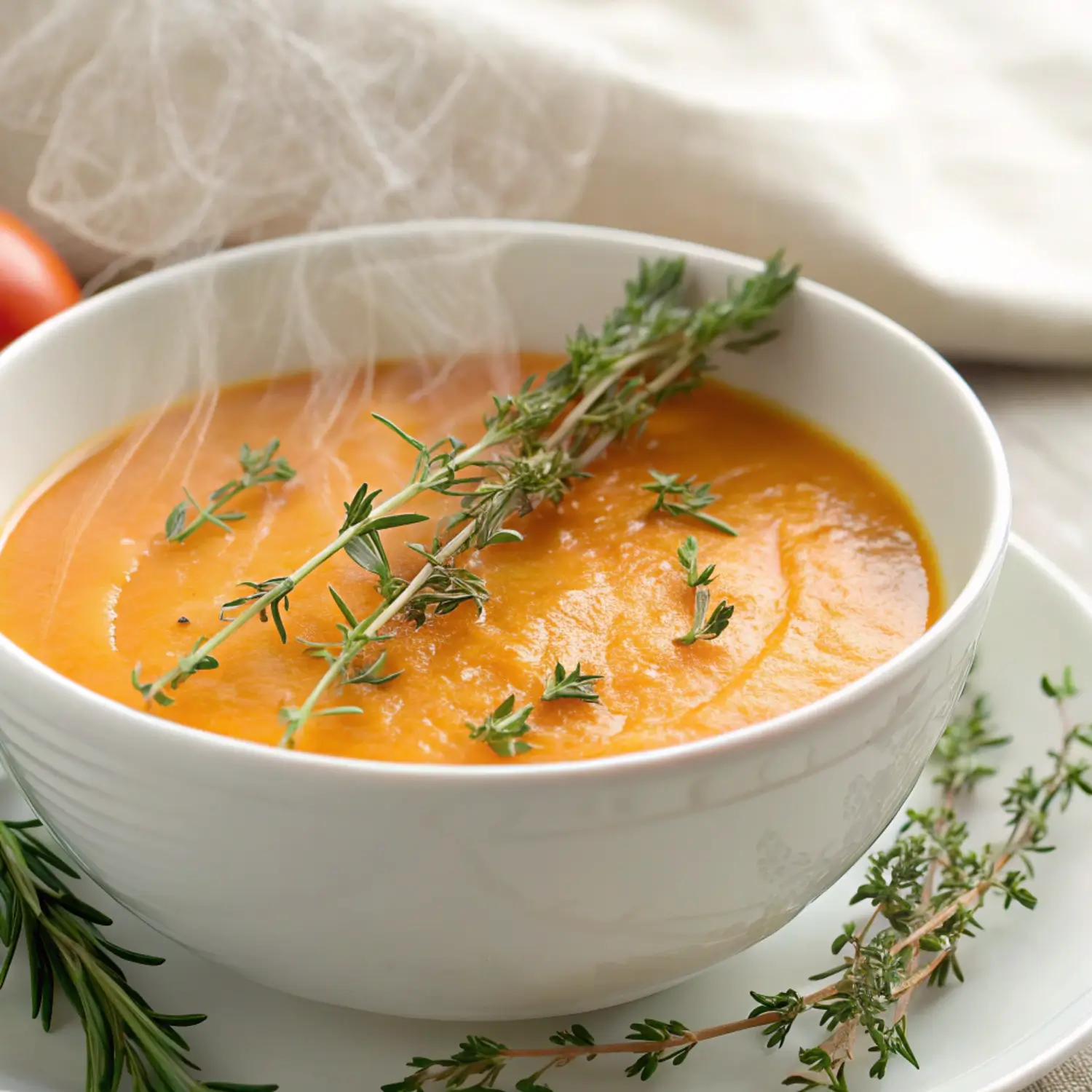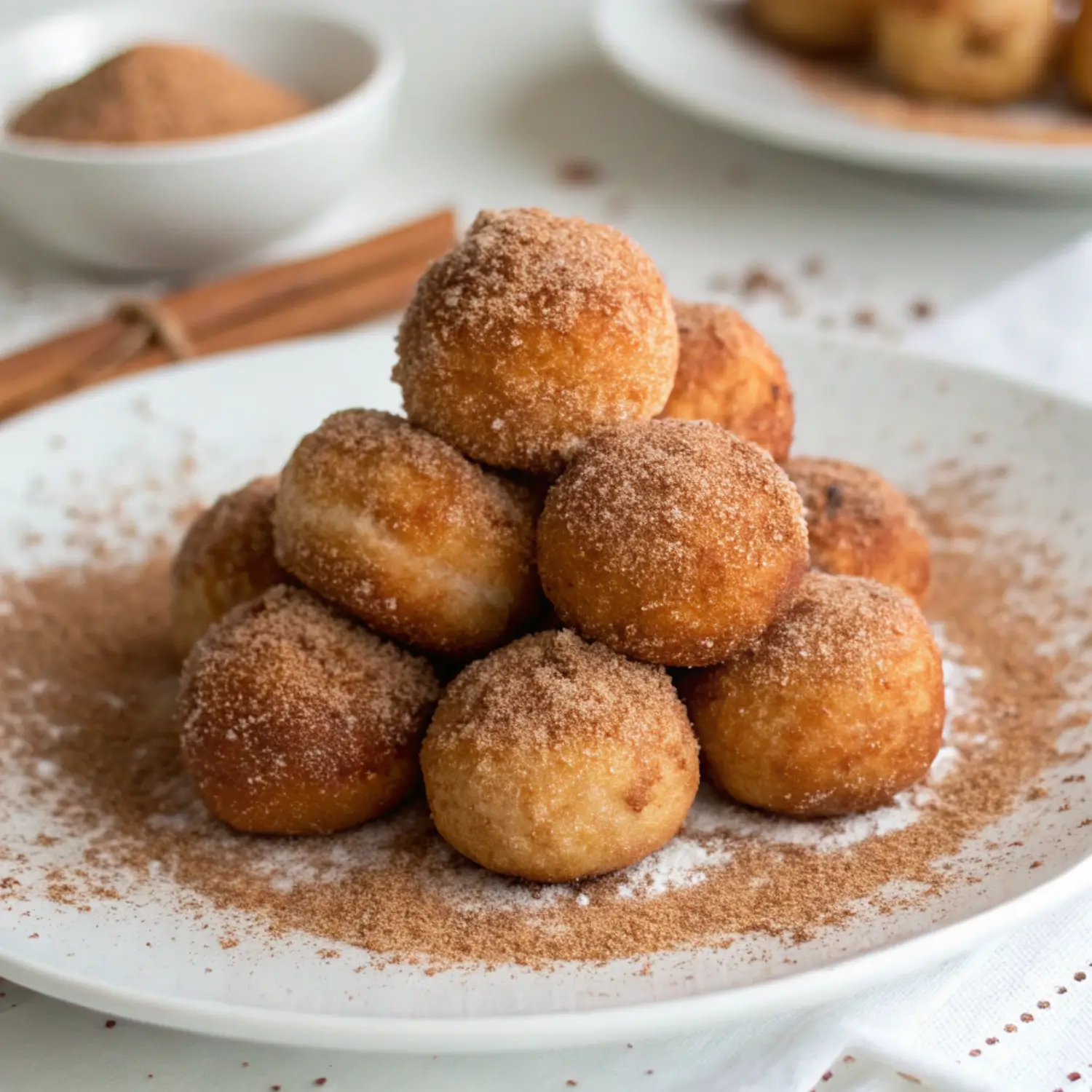Introduction to Hibachi Bowls
What Is a Hibachi Bowl?
A hibachi bowl is a Japanese-inspired dish that combines grilled proteins, stir-fried vegetables, and seasoned rice, often served with signature sauces like yum yum sauce or teriyaki sauce. The name “hibachi” refers to a traditional Japanese heating device, but in Western cuisine, it has evolved to describe a style of cooking where chefs grill food on a flat-top grill, often putting on an entertaining show at Japanese steakhouses.
Hibachi bowls have gained immense popularity due to their rich, smoky flavors and well-balanced nutritional profile. They offer a versatile meal that can be customized to suit different tastes, whether you prefer chicken, steak, shrimp, or even vegetarian options.
Origins and Cultural Significance
The word hibachi (火鉢) translates to “fire bowl” in Japanese and originally referred to a charcoal-heated cooking device used for centuries in Japan. However, the hibachi-style cooking that many people recognize today is more closely related to teppanyaki, which involves cooking food on a flat iron griddle. This style became popular in the U.S. in the mid-20th century, thanks to restaurants like Benihana, which combined cooking with entertainment.
Hibachi bowls take the essence of this cooking style and simplify it into a single, convenient dish that can be made at home. The combination of smoky grilled meats, sautéed vegetables, and fluffy fried rice creates a meal that’s both satisfying and visually appealing.
Components of a Hibachi Bowl
Creating a perfect hibachi bowl starts with choosing the right ingredients. From flavorful proteins to crisp vegetables and aromatic rice, every element plays a crucial role in making this dish stand out. Let’s break down the key components that make a hibachi bowl delicious and well-balanced.
Proteins: The Star of the Bowl
One of the most exciting aspects of hibachi bowls is the variety of protein choices. Each protein offers a unique texture and flavor, allowing you to customize the dish to your preference.
1. Hibachi Chicken
Lean, juicy, and packed with flavor.
Typically made with bite-sized chicken breast or thigh pieces.
Marinated in a blend of soy sauce, garlic, ginger, and sesame oil.
Grilled over high heat for a lightly charred exterior and tender interior.
2. Hibachi Steak
Rich, juicy, and full of umami goodness.
Common cuts include sirloin, ribeye, or filet mignon for the best texture.
Cooked to medium-rare or medium for optimal tenderness.
Often paired with garlic butter for extra depth of flavor.
3. Hibachi Shrimp
Light, slightly sweet, and quick to cook.
Deveined shrimp are grilled in a simple butter and garlic sauce.
A great option for seafood lovers or those looking for a lighter protein.
Complements both rice and vegetable pairings exceptionally well.
4. Vegetarian & Vegan Alternatives
Plant-based proteins that taste just as good.
Tofu: Firm or extra-firm tofu cubes marinated in soy sauce and grilled to a crispy texture.
Tempeh: A high-protein alternative with a nutty flavor that absorbs marinades well.
Seitan: A meat substitute with a chewy texture similar to chicken.
Vegetables: Fresh & Flavorful
Hibachi bowls are known for their vibrant, sautéed vegetables. Cooking them over high heat locks in their natural sweetness and creates a slightly crispy texture.
Most Common Vegetables Used in Hibachi Bowls:
✅ Zucchini: Adds a mild sweetness and pairs well with all proteins.
✅ Onions: Caramelizes beautifully and enhances the overall umami taste.
✅ Mushrooms: Absorb flavors from soy sauce and butter, creating a meaty bite.
✅ Carrots: Provide a natural sweetness and a pop of color.
✅ Broccoli: A great fiber-rich addition that retains a bit of crunch.
✅ Bell Peppers: Offer a mild, slightly sweet taste and brighten up the bowl.
👉 Pro Tip: Cook vegetables in sesame oil or butter to enhance their flavor and give them that classic hibachi-style taste.
Rice: The Perfect Base
The foundation of any hibachi bowl is the rice, which soaks up all the delicious sauces and flavors from the proteins and vegetables.
Types of Rice Used in Hibachi Bowls:
Hibachi Fried Rice: White rice stir-fried with eggs, garlic, butter, and soy sauce.
Brown Rice: A healthier alternative with more fiber and a nuttier taste.
Cauliflower Rice: A low-carb substitute that still soaks up sauces well.
👉 Pro Tip: Use day-old rice for the best fried rice texture—it prevents clumping and absorbs flavors more evenly.
Sauces: The Secret to Bold Flavor
Hibachi-style sauces tie all the elements together and add the signature umami-packed taste. Here are the most popular ones:
1. Yum Yum Sauce (A must-have!)
A creamy, slightly sweet and tangy sauce made with mayonnaise, tomato paste, rice vinegar, and seasonings.
Perfect for drizzling over proteins and rice.
2. Teriyaki Sauce
A glossy, sweet-savory glaze made from soy sauce, mirin, brown sugar, and garlic.
Best paired with chicken, steak, or tofu.
3. Ginger Sauce
A light, zesty sauce made with fresh ginger, soy sauce, vinegar, and onions.
Often served as a dipping sauce for hibachi proteins.
4. Spicy Mayo
A creamy sauce made with mayonnaise and sriracha.
Adds a subtle heat to hibachi bowls.
👉 Pro Tip: Want an extra burst of flavor? Try mixing different sauces together for a unique taste!
How to Make a Hibachi Bowl at Home
Now that you know the essential ingredients, it’s time to bring everything together and make a delicious, restaurant-quality hibachi bowl in your own kitchen. This step-by-step guide will walk you through the entire process, from marinating proteins to assembling the perfect bowl.
Step 1: Gather Your Ingredients
Before you start cooking, make sure you have everything ready. Here’s what you’ll need:
Protein Choices (Pick One or More)
✅ 1 lb chicken breast (cubed)
✅ 1 lb steak (sirloin or ribeye, cut into bite-sized pieces)
✅ 1 lb shrimp (peeled and deveined)
✅ 1 block extra-firm tofu (for a vegetarian option)
Vegetables
✅ 1 zucchini (sliced into half-moons)
✅ 1 onion (sliced)
✅ 1 cup mushrooms (sliced)
✅ 1 carrot (julienned)
✅ 1 cup broccoli florets
✅ ½ bell pepper (sliced)
Rice Base
✅ 2 cups cooked rice (preferably day-old)
Sauces & Seasonings
✅ 3 tbsp soy sauce
✅ 2 tbsp sesame oil
✅ 2 tbsp butter
✅ 1 tsp garlic (minced)
✅ 1 tsp ginger (grated)
✅ ½ tsp salt & pepper
👉 Pro Tip: Prepping ingredients before cooking ensures a smooth and enjoyable experience, just like in a hibachi restaurant!
Step 2: Marinate the Protein
Marinating your protein enhances its flavor and gives it that authentic hibachi taste. Here’s how:
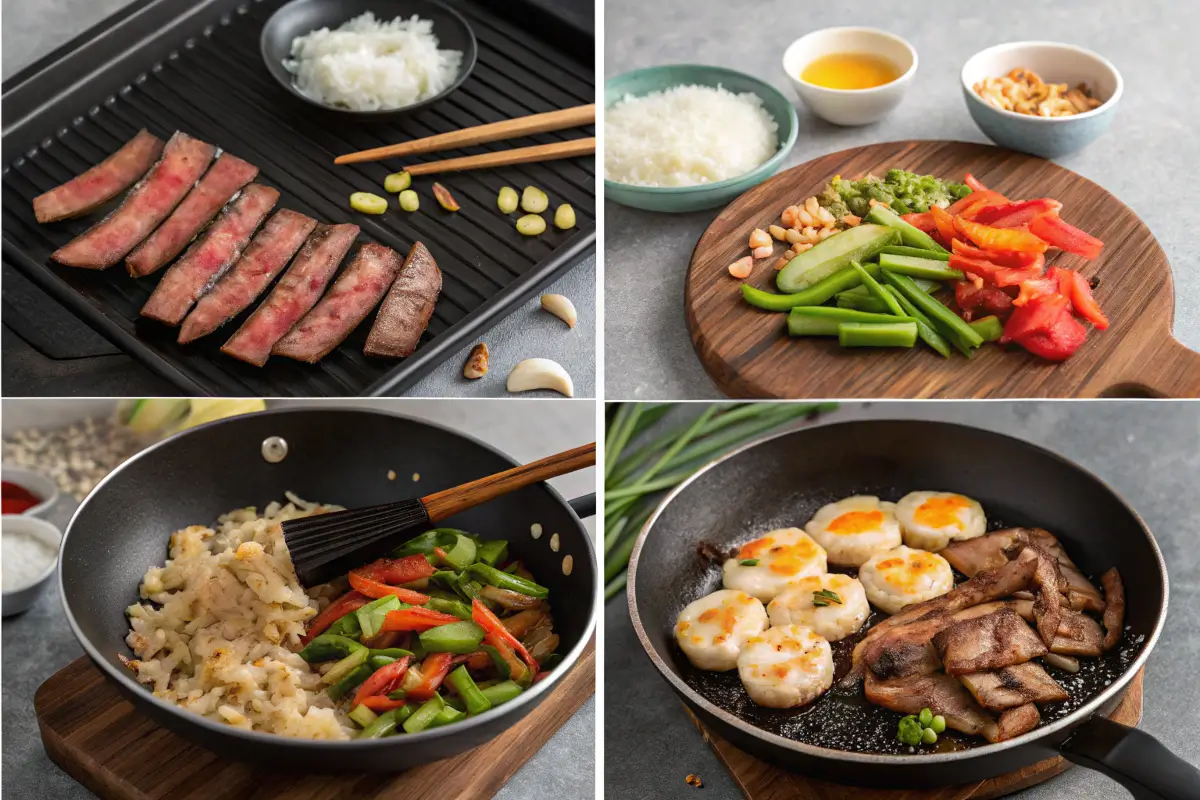
Hibachi Chicken & Steak Marinade
3 tbsp soy sauce
1 tbsp sesame oil
1 tbsp mirin (or honey for sweetness)
1 tsp grated ginger
1 tsp minced garlic
½ tsp black pepper
Instructions:
Combine all ingredients in a bowl.
Add the chicken or steak and toss to coat evenly.
Cover and let it marinate for at least 30 minutes (or overnight for deeper flavor).
Hibachi Shrimp & Tofu Marinade
2 tbsp soy sauce
1 tbsp lemon juice
1 tbsp sesame oil
½ tsp paprika
Instructions:
Coat shrimp or tofu with the marinade and let it sit for 15 minutes.
Avoid over-marinating shrimp as it can become mushy.
Step 3: Cook the Rice
Hibachi-style fried rice is a must! Follow these steps for the best texture:
How to Make Hibachi Fried Rice
1️⃣ Heat a large pan over medium-high heat. Add 1 tbsp butter and let it melt.
2️⃣ Add 1 scrambled egg, stirring continuously until cooked through.
3️⃣ Toss in the cooked rice, breaking up any clumps.
4️⃣ Season with 2 tbsp soy sauce, 1 tsp sesame oil, and a pinch of salt. Stir well.
5️⃣ Add ½ cup diced onions and carrots for extra flavor.
6️⃣ Stir-fry for 3-4 minutes until everything is heated through.
👉 Pro Tip: Using cold, day-old rice prevents it from becoming mushy when frying.
Step 4: Cook the Vegetables
Hibachi vegetables should be slightly tender but still crisp. Here’s how to cook them:
1️⃣ Heat 1 tbsp sesame oil in a pan over high heat.
2️⃣ Add onions, zucchini, mushrooms, carrots, and bell peppers. Stir-fry for 3-4 minutes.
3️⃣ Add broccoli and cook for another 2 minutes.
4️⃣ Stir in 1 tbsp soy sauce and 1 tbsp butter for extra flavor.
5️⃣ Remove from heat once vegetables are tender but still vibrant.
👉 Pro Tip: Cooking at high heat helps retain the vegetables’ natural sweetness and crunch.
Step 5: Cook the Protein
For Chicken & Steak
1️⃣ Heat 1 tbsp sesame oil in a pan or grill over high heat.
2️⃣ Add marinated chicken or steak and cook for 3-5 minutes per side, until nicely seared.
3️⃣ Remove from heat and let it rest for 2 minutes before slicing.
For Shrimp
1️⃣ Heat 1 tbsp butter in a pan over medium-high heat.
2️⃣ Add shrimp and cook for 1-2 minutes per side until pink and opaque.
For Tofu
1️⃣ Heat 1 tbsp sesame oil in a pan.
2️⃣ Add tofu cubes and cook for 3-4 minutes per side until crispy.
Step 6: Assemble Your Hibachi Bowl
Now comes the fun part—putting it all together!
Start with the rice as the base of your bowl.
Add the cooked protein (chicken, steak, shrimp, or tofu).
Layer the sautéed vegetables on top.
Drizzle with your favorite sauce (Yum Yum, Teriyaki, or Ginger Sauce).
Garnish with sesame seeds and chopped green onions for extra flavor.
✅ Your homemade hibachi bowl is ready to enjoy!
Bonus Tip: Make It a Meal Prep Option
Hibachi bowls are great for meal prepping! Here’s how:
🥡 Store cooked rice, protein, and vegetables separately in airtight containers.
🥡 Reheat in a pan to maintain texture and freshness.
🥡 Keep sauces on the side to drizzle fresh before eating.
Variations, Healthy Alternatives, and Customization Options
Now that you’ve mastered the classic hibachi bowl, it’s time to get creative! Whether you’re looking for healthier swaps, unique flavors, or diet-friendly versions, this section will guide you through exciting variations.
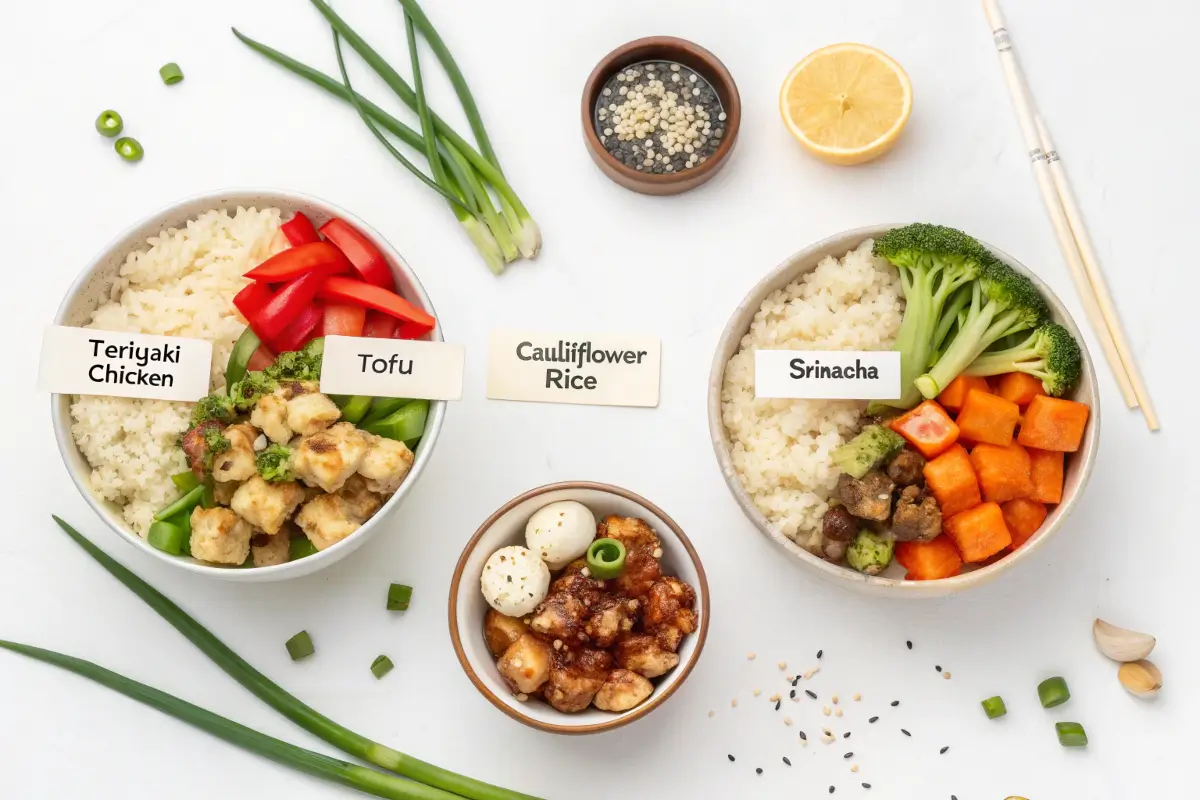
Hibachi Bowl Variations
Hibachi bowls are incredibly versatile, and small tweaks can lead to entirely new flavor profiles. Here are some exciting ways to switch up your bowl:
1. Spicy Hibachi Bowl 🌶️🔥
Love heat? Kick up the spice level by:
✅ Adding sriracha or chili oil to your protein marinade.
✅ Mixing spicy mayo (sriracha + mayonnaise) into your bowl.
✅ Sprinkling crushed red pepper flakes for an extra punch.
2. Teriyaki Hibachi Bowl 🍯🍶
For a sweeter, more glazed version, try:
✅ Swapping soy sauce for teriyaki sauce when cooking protein and rice.
✅ Drizzling extra teriyaki sauce on top for a glossy finish.
✅ Garnishing with pineapple chunks for a tropical touch.
3. Garlic Butter Hibachi Bowl 🧄🧈
A rich and indulgent twist featuring garlicky goodness:
✅ Cooking your protein in a garlic butter sauce.
✅ Tossing vegetables in melted garlic butter before serving.
✅ Adding a dollop of garlic-infused butter on top of hot rice.
4. Keto & Low-Carb Hibachi Bowl 🥑🥦
Want to cut carbs while keeping the flavors? Try this:
✅ Replacing rice with cauliflower rice or shirataki noodles.
✅ Using coconut aminos instead of soy sauce for a lower-carb alternative.
✅ Loading up on extra vegetables for a fiber-rich meal.
5. Vegan Hibachi Bowl 🌱🥢
Plant-based but still packed with flavor:
✅ Swapping protein for tofu, tempeh, or seitan.
✅ Using vegan butter for sautéing veggies and rice.
✅ Drizzling with vegan yum yum sauce (made with plant-based mayo).
👉 Pro Tip: Customize your bowl with your favorite ingredients to create a version that fits your taste and dietary needs!
Healthy Alternatives for a Nutritious Hibachi Bowl
Want to enjoy a guilt-free hibachi bowl without compromising on taste? Here’s how:
1. Choose Lean Proteins
🔹 Chicken breast instead of thighs.
🔹 Shrimp or tofu instead of steak.
🔹 Egg whites instead of whole eggs in fried rice.
2. Use Healthier Cooking Oils
🔹 Avocado oil or coconut oil instead of butter for stir-frying.
🔹 Sesame oil in moderation for flavor without excess fat.
3. Reduce Sodium & Sugar
🔹 Low-sodium soy sauce instead of regular.
🔹 Coconut aminos as a soy-free alternative.
🔹 Honey or monk fruit instead of refined sugar in sauces.
4. Opt for Whole Grains
🔹 Brown rice instead of white rice for more fiber.
🔹 Quinoa as a protein-rich alternative.
5. Load Up on Veggies
🔹 Increase zucchini, mushrooms, and broccoli to add more nutrients.
🔹 Add leafy greens like spinach or kale for extra vitamins.
For authentic Japanese flavors, check out this comprehensive guide to soy sauces and choose the best one for your hibachi bowl.
Creative Toppings & Garnishes
Want to make your hibachi bowl even more exciting? Try these toppings:
✅ Sesame seeds – Add a nutty crunch.
✅ Green onions – Freshen up every bite.
✅ Nori (seaweed flakes) – Boost umami flavor.
✅ Pickled ginger – A tangy contrast to rich flavors.
✅ Crushed peanuts or cashews – A great texture boost.
👉 Pro Tip: Experiment with different textures and flavors to elevate your hibachi bowl experience!
Frequently Asked Questions & Expert Tips for the Perfect Hibachi Bowl
To wrap up this ultimate guide to Hibachi Bowls, we’ll address some common questions and provide expert tips to help you achieve restaurant-quality results at home.
Frequently Asked Questions (FAQ)
1. What’s the difference between a hibachi bowl and a teriyaki bowl?
A hibachi bowl is cooked on a high-heat grill, with butter, garlic, soy sauce, and sesame oil, giving it a smoky, rich flavor. A teriyaki bowl, on the other hand, features a sweeter, thicker glaze made from soy sauce, mirin, and sugar.
2. Can I make a hibachi bowl without a hibachi grill?
Yes! You can replicate the high heat by using:
✅ A cast-iron skillet for even heat distribution.
✅ A wok for quick stir-frying.
✅ A griddle pan to mimic the flat-top grill used in hibachi restaurants.
3. What’s the best rice for a hibachi bowl?
Day-old jasmine or short-grain rice is ideal. Freshly cooked rice can be too soft, while day-old rice has the right texture for perfect fried rice.
4. How do I make my hibachi vegetables taste like the ones in restaurants?
The secret is:
✅ High heat cooking – Quickly stir-fry to maintain crispness.
✅ Butter & soy sauce – Adds that signature flavor.
✅ Garlic & sesame oil – Enhances the aroma and taste.
5. How do I store and reheat leftovers?
🔹 Storage: Keep rice, protein, and vegetables in separate airtight containers in the fridge for up to 4 days.
🔹 Reheating: Stir-fry in a hot pan for a few minutes to restore texture and flavor.
Expert Tips for the Best Homemade Hibachi Bowl
1. Use the Right Cooking Techniques
✅ Sear the protein at high heat to create a flavorful crust.
✅ Stir-fry in batches so ingredients don’t steam.
✅ Let the steak rest before slicing to keep it juicy.
2. Balance the Flavors
✅ Soy sauce + butter gives that classic umami taste.
✅ A touch of sweetness (honey or mirin) enhances depth.
✅ Acidity (lemon juice or rice vinegar) balances richness.
3. Don’t Overcook the Protein
Shrimp should turn pink, steak should be cooked to your desired doneness, and chicken should be tender, not dry.
4. Customize to Your Taste
Feel free to experiment with different proteins, vegetables, and sauces. Make it spicy, sweet, or even keto-friendly!
Final Thoughts
With this ultimate guide, you now have everything you need to make a delicious, restaurant-style hibachi bowl at home! Whether you prefer classic hibachi, spicy variations, or healthier alternatives, the possibilities are endless.
🔥 Now it’s your turn! Try making a hibachi bowl and enjoy the flavors of Japanese-style grilling right in your kitchen.
If you love rich, creamy flavors, try this Marry Me Chicken Pasta for a luxurious and easy-to-make meal!
Happy cooking! 🍽️✨
Print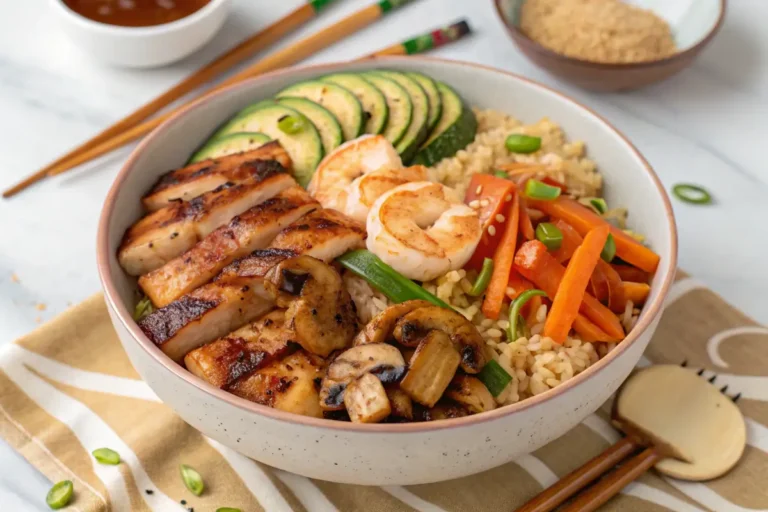
Hibachi Bowl – Easy, Flavorful, and Better Than Takeout!
This homemade Hibachi Bowl is a quick, easy, and delicious meal packed with grilled protein, savory fried rice, and fresh veggies. Skip the restaurant and make this authentic Japanese-inspired dish at home in just 30 minutes!
- Total Time: 30 minute
- Yield: 4 servings 1x
Ingredients
For the Hibachi Chicken (or Steak/Shrimp):
1 lb chicken breast (or steak/shrimp), cut into bite-sized pieces
2 tbsp soy sauce (low sodium recommended)
1 tbsp sesame oil
1 tbsp butter
1 tsp garlic (minced)
½ tsp ginger (grated)
1 tbsp teriyaki sauce (optional, for extra flavor)
For the Hibachi Fried Rice:
2 cups cooked rice (preferably day-old)
2 tbsp butter
1 tbsp soy sauce
1 tsp sesame oil
1 egg, scrambled
¼ cup onion (finely chopped)
½ cup peas and carrots mix
For the Hibachi Vegetables:
1 cup zucchini (sliced into half-moons)
½ cup mushrooms (sliced)
½ cup onion (sliced)
1 tbsp butter
1 tbsp soy sauce
For the Yum Yum Sauce:
½ cup mayonnaise
1 tbsp ketchup
1 tsp paprika
1 tsp sugar
1 tbsp butter (melted)
1 tsp garlic powder
1 tbsp water (to thin)
Instructions
Step 1: Prepare the Hibachi Chicken (or Steak/Shrimp)
Heat a large griddle or skillet over medium-high heat and add sesame oil.
Add chicken/steak/shrimp and cook for 5–7 minutes, stirring occasionally.
Add garlic, ginger, soy sauce, and butter, and sauté for another 2 minutes until fully cooked.
Remove from heat and set aside.
Step 2: Make the Hibachi Fried Rice
In the same skillet, melt butter over medium heat.
Add onions, peas, and carrots, sauté for 2 minutes until soft.
Push veggies to one side, then scramble the egg on the empty side.
Add rice, soy sauce, and sesame oil, and stir-fry for 3–4 minutes.
Step 3: Sauté the Hibachi Vegetables
In a separate pan, melt butter over medium-high heat.
Add zucchini, mushrooms, and onion, then cook for 3–4 minutes.
Drizzle with soy sauce, stir, and cook for another 2 minutes.
Step 4: Prepare the Yum Yum Sauce
In a bowl, mix mayonnaise, ketchup, paprika, sugar, garlic powder, melted butter, and water.
Stir well and refrigerate for at least 15 minutes before serving.
Step 5: Assemble the Hibachi Bowl
Add a generous serving of fried rice to a bowl.
Top with hibachi chicken (or steak/shrimp) and sautéed vegetables.
Drizzle with Yum Yum sauce, and enjoy your homemade Hibachi Bowl!
Notes
For extra flavor, add a splash of teriyaki sauce to your protein.
Use day-old rice for the best fried rice texture.
Make it spicy! Add sriracha or red pepper flakes to the Yum Yum sauce.
- Prep Time: 15 minute
- Cook Time: 15 minute
- Category: Main Course
- Method: Stir-Frying, Grilling
- Cuisine: Japanese
- Diet: Gluten Free
Nutrition
- Serving Size: 1 bowl
- Calories: ~450 kcal
- Sugar: 3g
- Sodium: 720mg
- Fat: 18g
- Saturated Fat: 5g
- Unsaturated Fat: 10g
- Trans Fat: 0g
- Carbohydrates: 45g
- Fiber: 3g
- Protein: 28g
- Cholesterol: 85mg
Keywords: Hibachi bowl, Japanese hibachi recipe, easy hibachi chicken, homemade hibachi, fried rice, healthy Japanese food
